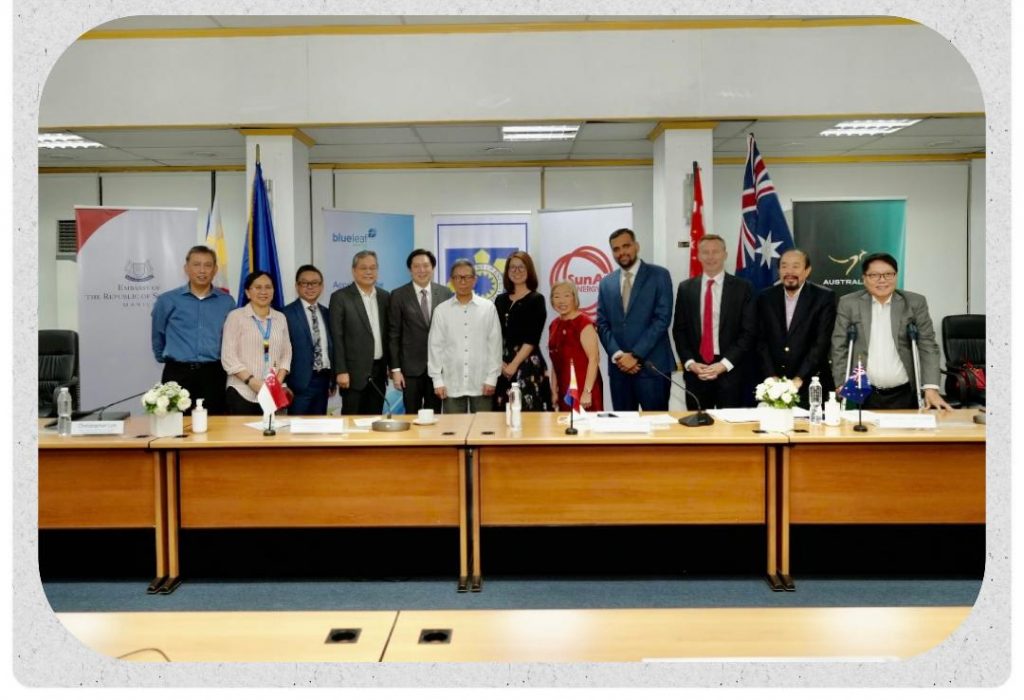
SEOCs turnover ceremony with Blueleaf Energy CEO, Raghuram Natarajan (4th from the right),SunAsia CEO and President, Tetchi Capellan (5th from the right),DOE Secretary Raphael P. M. Lotilla (7th from the right), Australian Ambassador to the Philippines, HE HK Yu PSM (6th from the right), Singaporean Ambassador to the Philippines, HE Gerard Ho Wei Hong (5th from the left), Senior Trade and Investment Commissioner (AusTrade), Christopher Lim (3rd from the left), Laguna Lake Development Authority General Manager, Atty. Senando Santiago (4th from the left), and ceremony guests.
The Philippine government has awarded contracts to SunAsia Energy Inc. and Blueleaf Energy to construct and manage the largest floating solar project in the world, with a total capacity of more than 610.5 megawatts (MW).
The Department of Energy (DoE) has issued the first batch of Solar Energy Operating Contracts (SEOCs) for a total of 1.3 gigawatts (GW) in floating solar projects, marking a significant development in the nation’s energy sector.
During President Ferdinand Marcos Jr’s state visit to Singapore in September 2022, Blueleaf Energy, a standalone portfolio company of Macquarie, signed a Letter of Intent (LOI). In the Philippines, the firm promised to considerably increase its investments in sustainable infrastructure.
In partnership with SunAsia Energy, Blueleaf Energy is jointly developing the large-scale floating solar facility on Laguna Lake, spanning the growing cities of Calamba, Sta. Rosa and Cabuyao, and the towns of Bay and Victoria.
During the contract turnover ceremonies, Energy Secretary Raphael Lotilla reiterated his promise to strengthen the renewable energy sector and declared the DoE’s strong support for the commercialization of floating solar facilities as an emerging technology.
Australian Ambassador HK Yu PSM and Singaporean Ambassador Gerard Ho Wei Hong were among those who attended the event at the DoE office in Makati City. The program echoed the need to accelerate the realization of the country’s decarbonization targets by 2040.
Raghuram Natarajan, CEO of Blueleaf Energy, said that “as an active investor in sustainable infrastructure in the Asia Pacific region, we believe the Philippines holds great potential to add significant renewable energy capacity to its energy mix and at the same time delivering green energy at an affordable cost compared to fossil fuels.”
The recent announcement of the removal of foreign ownership restrictions, Mr. Natarajan said, “is an important step in attracting the much-needed foreign direct investments in Philippine Renewable Energy (RE) sector to accelerate the energy transition for meeting the country’s decarbonization and net zero targets.”
After the signing of the SEOCs, Blueleaf Energy’s top executive said his company would push for cooperation among public and private stakeholders to ensure the successful development of the project.
This will “not only contribute to the country’s RE goals, but also spark green job growth locally during construction and the long-term operations of these floating solar projects, enable local supply chains through the manufacturing of critical components and bring about notable benefits to the local community,” Mr. Natarajan said.
The SEOC is a testament to the viability of this emerging technology. Tetchi Capellan, president and CEO of SunAsia Energy, noted that “land use is becoming a big issue for renewables.”
“People are worrying about competing uses of land, and in some markets, you might struggle to find land,” Capellan said. “There is a strong incentive to build on water as the Philippines gears up for an ambitious 46 GW solar energy installations in 2040 and at the same time, increase power supply in the country.”
She said that this first 610MW floating solar project “is our collective legacy, our immeasurable contribution to the body of knowledge in the renewable energy space and to the growing solar energy installations worldwide.”
“Once built, we are certain that it will stand as one of the engineering wonders of the world. It will capture the imagination of developers, it will be published in multiple journals, shared in social media, visited by hundreds of practitioners, and studied by academics,” Capellan added.
Since 2019, SunAsia Energy has been operating a testbed on Laguna Lake to study the behavior of waves, the movement of wind, the intensity of the sun, as well as the variability of the temperature in the locality. The wealth of experience has contributed to the growing knowledge of floating solar panels on the lake.
SunAsia Energy further explained that like land-based systems, floating solar panels generate electricity from the sun’s rays. But the bodies of water that these farms rest on also help to cool the panels, allowing them to be more efficient than terrestrial solar, according to the Environmental and Energy Study Institute.
Solar-on-water will definitely boost clean power as the world races to cut carbon emissions. Massive solar farms can now be found atop bodies of water in South Korea, Japan, China, Thailand, Singapore, and Portugal.
Developing solar-on-water projects, in the country’s largest lake, will help achieve not only the government’s ambitious decarbonization target but also much needed power to run industries, light homes, and energize cities.
More importantly, it will be a legacy of the Philippines to the global renewable energy space, SunAsia Energy said.
In the last two decades, Blueleaf Energy has developed and built almost 2 GW of solar capacity across the globe, including 250 MW in the Philippines. It currently has over 7 GW of solar, wind and storage projects project pipeline across the Asia Pacific region.
Since its founding in 2013, SunAsia Energy, a national developer of renewable solar energy, has collaborated with numerous organizations to create solar projects, such as the 20 MWp Dagupan solar project in Pangasinan and the 60 MWp Toledo solar project in Cebu.

No Comments